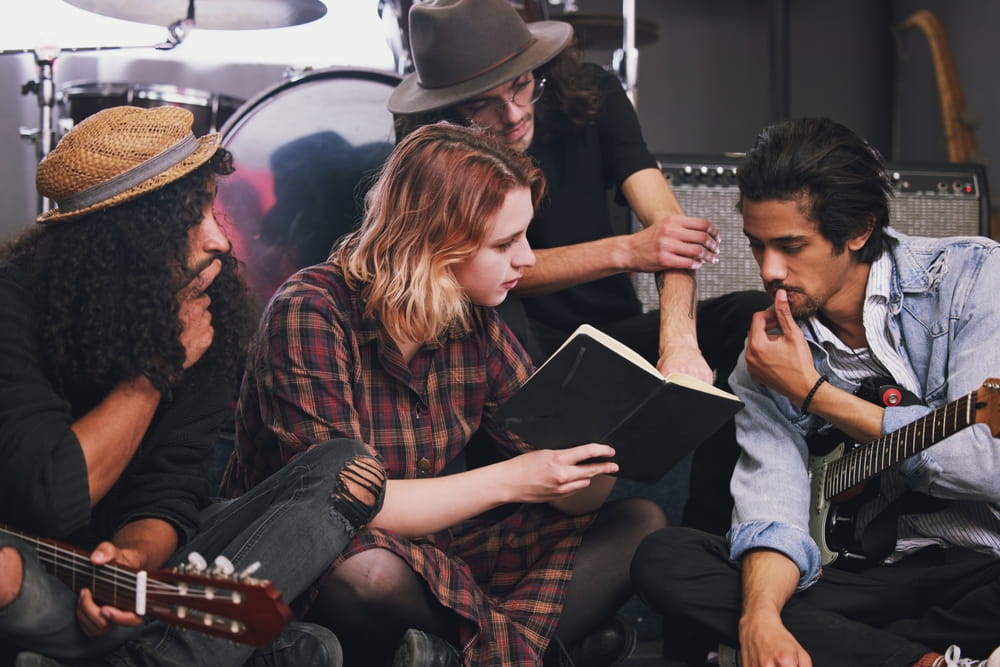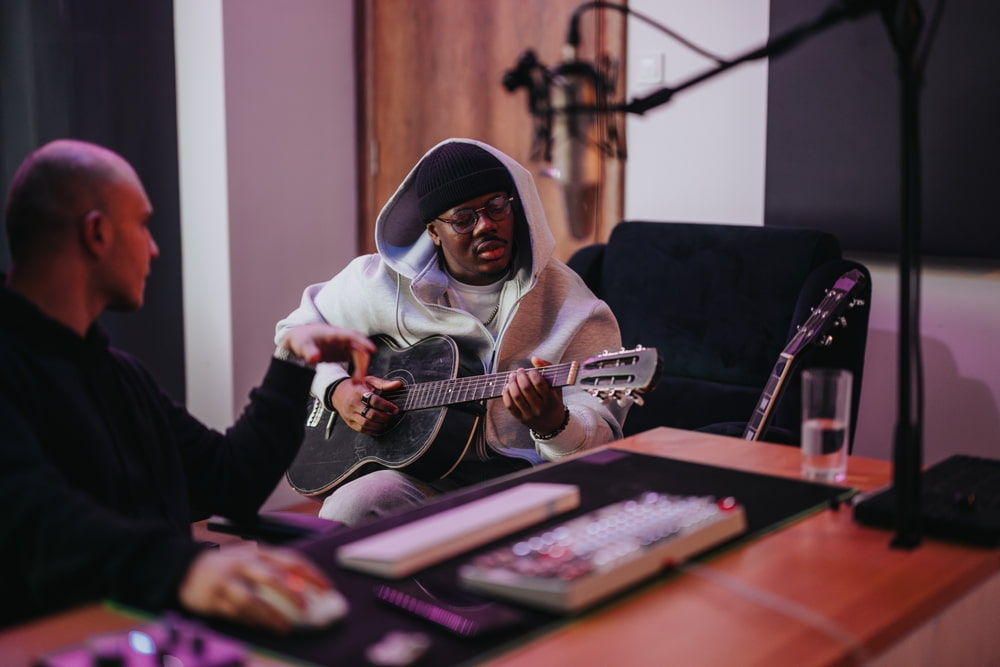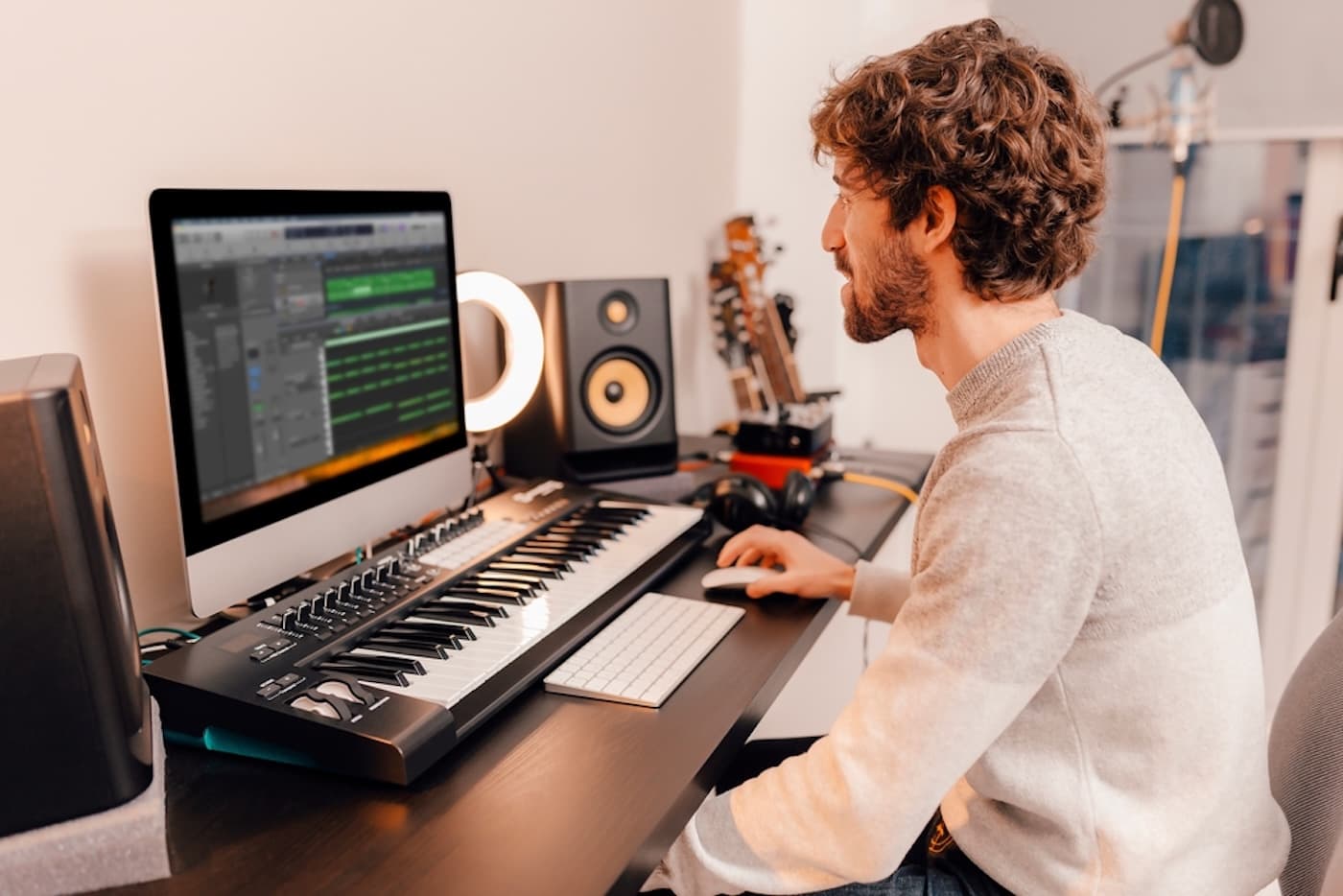Selling merchandise is one of the most effective ways for bands to earn money and supplement income from gigs.
The best band merch ideas can not only generate extra revenue but also put your band’s brand in the spotlight.
In this guide, we’ve pulled together 25 creative merch ideas you can try, ranging from classic apparel to unique collectibles that fans will love.
Get Early Access
To Promo Hype
What Makes Good Band Merchandise?
Before deciding what merchandise you want to sell, it’s essential to understand the qualities that make them appealing.
Here are some elements of outstanding attributes of successful band merchandising that appeal to fans:
- A strong and authentic brand identity: With a rich history of band merchandise, there’s no shortage of references surrounding strong and memorable branding. Your merch line should fit clearly within your broader branding style, using your band’s logo, album art, and other familiar visual elements.
- High-quality materials and production: With numerous online selling platforms, it can be challenging to select one that consistently delivers quality. Check out user and customer reviews to ensure your band merch ideas are accurately brought to life.
- Variation of merch line products: Building a merch line takes time, but as a good rule of thumb, selling a variety of products is key to success. As your sales data comes in, you can refine your merch lineup to include products with a proven track record.
- Release merch that brings value to fans: Some merch ideas are an excellent way to get fans to serve as ambassadors, such as through clothing. That said, offering merch such as tutorials explaining how to make music can bring real value that fans love.
By responding to feedback from fans and measuring sales, you can create custom designs that reflect your band’s personality.
Key Considerations For Band Merch Ideas
There’s an abundance of band merch swamping online selling websites, so creating something unique will help your products stand out.
Here are some ways you can make cool band merch ideas and incorporate them into your music marketing strategies:
- Think outside the box: T-shirts, keypins, and other common merchandise ideas can sell well, but if you have a feasible novelty concept, don’t be afraid to try it.
- Release limited-edition merchandise: Scarcity is an excellent way to drum up enthusiasm for merchandise, making limited-edition releases highly sought after by fans.
- Time merch releases to events: If you have a tour or new album in the pipeline, creating bespoke merch for these events can help with promotion.
Encouraging fan participation and running design contests are other popular methods for generating new and unique band merch ideas.
25 Best Bands Merch Ideas In 2025
Brainstorming merch ideas is a core aspect of capitalizing on revenue streams to supplement income from streaming and gigs.
Here are 25 merch ideas you can use for your band, from tried-and-tested physical merch to scalable digital merchandise.
Custom Physical Merch
Physical merchandising has been generating revenue for bands for decades, from tour posters and tees to exclusive, limited-edition releases.
Here are some popular merch ideas you can sell through your online store:
25. Keychains
Revenue generated from merch sales delivers a passive income, allowing bands to focus on producing music for their fans.
Keychains are an excellent example of affordable merchandise that fans can purchase from your store or at gigs.
You can print your band’s logo on the keychain, or experiment with different merch designs based on upcoming tours or band members.
24. Stickers
Like keychains, band stickers are low-cost options for merchandise, both in terms of production costs and the price for fans.
There’s more scope here for creativity, with album covers, logos, and other design elements all applicable to the format.
Adding slogans or snippets from your song lyrics is another excellent way to make your band stickers memorable.
Discover more: How to get signed to a record label.
23. Pins & Patches
Wearable merchandise can be an effective tool for promotion, sharing your band’s brand in public spaces.
Pins and patches featuring your logo, album art, and other graphics can make an instant impression, capturing the tone of your music.
Patches in particular are popular among metal music fans, so if that’s your genre, consider creating several patch designs.
22. Fanny Packs & Backpacks
Print-on-demand services offer an impressive selection of merchandise that you can brand, including various types of bags and backpacks.
You can apply branding to fanny packs, tote bags, and larger bags, such as rucksacks, each with unique designs.
21. Slipmats
Slipmats are a popular form of merchandise in the electronic dance music community, particularly among DJs who enjoy mixing on turntables.
That said, bands can also sell slipmats, with many rock music fans keen collectors of vinyl records and limited editions.
It’s another excellent way to make money as a music producer and showcase your band’s logo and brand to the world.
20. Branded Musician Accessories
Many music fans are aspiring musicians in their own right, and branded musical accessories are among the merchandise they enjoy.
You can apply your branding to accessories, such as guitar picks and drumsticks, and sell them in your own online store.
For an additional fee, you can offer fans custom guitar picks featuring a design of their choice.
19. Band Sheet Music
On the subject of musically minded fans, guitarists and other musicians often seek out sheet music of their favorite band’s songs.
You can sell this through a print-on-demand service, adding new sheet music as and when your discography expands.
This can be augmented with notes, such as explaining the creative process behind composing types of chords and melodies.
18. Notebooks & Journals
Branded notebooks and journals are another tried-and-tested merchandise idea that sells well with minimal upfront costs.
Create a lineup of notebooks with band artwork from your album releases, or keep things simple with a logo.
You can also offer custom editions, which fans can use to plan their own music projects, outlining song structure and lyrics.
17. Coasters & Mugs
Coasters and mugs are another high-visibility product that owners see every day, whether at home or working in the office.
By creating various color schemes and designs, fans can select the versions that best match their home decor.
Recommended read: The ultimate guide to artist management.
16. Branded Phone & Tablet Cases
Selling smartphone and tablet cases is another hugely popular approach to branded merch that many other bands engage in.
You can include multiple designs in your store, ranging from logos and artwork to designs inspired by upcoming tours and shows.
Ensure that you include various phone and tablet sizes, so your cases are compatible with your fans’ devices.
15. Prints, Powers, & Canvas
Posters, prints, and canvases have been ubiquitous features adorning the walls of teenagers’ bedrooms for many decades.
While tour posters are among the most common merch for bands, there’s no limitation on the designs you can offer.
You can also consider holographic and metal-printed wall art, experimenting with different graphic design styles.
14. Hats & Caps
Hats, caps, and other forms of headgear have a proven track record of generating sales and dominating your merch game.
Take inspiration from the best music producers of all time, researching how they incorporate branding elements across their product range.
13. T-Shirts & Hoodies
Among the best-selling merch ideas you can try, T-shirts and hoodies are usually the first step bands take when creating merch.
Some of the best band T-shirts of all time have had a profound influence on fashion and culture, becoming iconic symbols of their respective artists.
Hoodies and tees essentially serve as “walking billboards,” so it pays to take your time when creating stunning designs.
12. Limited Edition Vinyl Records
While most people listen to music on streaming platforms, many still appreciate the sound quality and tactile nature of vinyl records.
Selling limited-edition vinyl records can deliver a substantial profit margin and help create word of mouth among like-minded music fans.
When pressing records, ensure that your tracks have been mixed and mastered to sound their best on all systems.
Get Early Access
To Promo Hype
Custom Digital Merch
While a physical merch lineup is essential, there’s potential for upfront costs and lower profit margins if sales underperform.
Consider adding these custom digital merch ideas to your lineup and offer fans additional ways to support your band.
11. Video Messages
While some merch can be mass-produced, other ideas deliver a personal touch that fans can truly cherish.
Video messages are easy to create but can leave a long-lasting impression on fans that builds loyalty.
You can share them on your band website with an access code or send them as a direct message on TikTok, Instagram, or Kick.
10. One-On-One Lessons
Another excellent merch idea that can bring in additional income is providing one-on-one lessons, either individually or in group sessions.
These can explore everything from breaking down how your band approaches song structure to navigating the music scene.
As your experience with lessons grows, you can refine a curriculum that offers creative value to your fan base.
9. Digital Stickers & Emojis
Physical stickers are popular among fans, but their digital equivalents, along with bespoke emojis, can also sell regularly.
Designs can cover the core bases of album art and your band’s logo, while emojis provide opportunities for animated content.
This merch can also be customized at the request of fans, creating dedicated digital merch at an additional price.
8. Video Tutorlals
The internet is awash with video tutorials on a wide range of topics, and bands can capitalize on this general thirst for knowledge.
Post your tutorials behind a paywall on your website, or upload them for free on YouTube and monetize your channel.
Like one-on-one lessons, video tutorials are an excellent way to share your creative workflow and encourage other musicians.
Learn more: The best music production schools.
7. Exclusive Content For Gamers
The gaming industry continues to expand, with platforms like Fortnite and Animal Crossing encouraging players to design their own levels.
Bands can use these platforms to create exclusive content for the gaming community, such as themed levels and characters.
You can also consider installing custom songs on Naysy, the Australian virtual reality content creator of the rhythm game Beat Saber.
6. Desktop Wallpaper Packs
Themed desktop wallpapers are as old as the internet, and a great way for bands to showcase their new album artwork.
Creating numerous designs and variations is easy with basic image design and editing tools, allowing you to update your selection over time.
As with digital stickers and emojis, you can also create wallpapers for specific music releases and upcoming tour dates.
5. Remix & Stems Packs
Another merch idea that bands can use to encourage their fans’ creative journey is by selling packs of remixes and stems.
These can be used in music production software by aspiring producers to create their own versions of their favorite songs.
Bands can further encourage participation by running remix contests, judging the entries, and offering prizes for the best submissions.
4. Digital Fanzines & eBooks
Music fans love to read more about their favorite band, whether it’s insights into their creative approach or personal lives.
Digital fanzines and other eBooks allow bands to share these insights while also generating additional income.
You can set up a subscription system for ongoing purchases, working with designers to ensure the fanzines look their best.
Topics can include everything from exploring how you became a music producer to life on the road when touring.
For eBooks, a more in-depth approach is preferable; consider using this format for books that explore the band’s history and ethos.
3. Sample Packs & Digital Downloads
Selling stems from your band’s music can be elevated with additional resources to help fans unleash their creativity.
Sample packs are easy to compile, and you can achieve this when recording music and saving individual instrument tracks.
These can then be sold as digital downloads on your website or through third-party sample pack providers.
Aim to include a variety of samples in each pack, including drums and basslines, as well as synths, guitar chords, and melodies.
2. NFTs/Collectibles
While NFTs and other digital collectibles might not be as popular as they once were, there’s still a market for this type of merch.
Indeed, many artists are engaging in NFT projects to expand their online reach and engage with their dedicated fans.
This can be exclusive digital artwork inspired by your latest album, or NFT-based exclusive tracks and previews.
NFTs can also be used as tickets for exclusive events, meet-and-greets, and other in-person events you’re planning.
Likewise, NFT-based virtual concerts and other online events are different options to consider when applying the format.
1. Exclusive Digital EPs & Singles
Perhaps the most popular type of digital merch is exclusive music releases, such as digital EPs and singles of previously unreleased tracks.
This format can be applied to all popular music genres, launching the releases on a variety of digital platforms.
You can sell directly to fans through websites like Bandcamp or through digital music distribution services.
Pre-save campaigns are an excellent way to generate buzz while also securing orders before the release day.
By offering exclusive bonus tracks and behind-the-scenes content, fans are happy to pay a premium for such releases.
Related read: EP vs. LP vs. Album: What’s the difference?
Creative Band Merch Idea Tips
With numerous merchandise options, knowing how to approach the branding process for multiple products can be challenging.
Follow these essential tips to streamline the design process and start selling band merch that fans love:
- Understand audience demographics: A core tenet of sales is understanding where your customers are based and their lifestyles and habits. By gauging the age range, gender, and location of fans, you can use targeted advertising to reach them directly.
- Focus on fan engagement: Once you’ve reached out to your fans, ongoing engagement is an excellent way to turn them into merchandise customers. You can offer your most dedicated fans custom merch, such as signed album artwork or even meet-ups.
- Apply A/B testing: A/B testing is commonly used in marketing to assess which branding assets elicit the most positive responses. Band merch ideas can also benefit from the process of determining fan preferences.
- Promote your merchandise online: Marketing your band merch is as important as promoting your music and upcoming tour dates. You can combine these elements into a single campaign, linking to new music and merch in each ad.
If you have live performances in the pipeline, selling your band’s merch items directly to your fan base is a must.
Best Custom Band Merch Resources
Not everyone has professional experience in graphic design, but that doesn’t mean you can’t create a visually striking merch lineup.
Here are some valuable resources you can use to bring your creative band merch ideas to life and reach fans:
Graphic design software: Free platforms like Canva offer a range of design tools for beginners to explore when creating merchandise. For more professional results, software like Adobe Illustrator and Rebelle delivers robust tools for designing your band’s logo and other art.
Website builders: If you want to cut out the middleman and sell directly from your band website, you’ll need a website builder. These are easy to use, featuring drag-and-drop functionality and tools for managing an online store.
Print-on-demand services: Whether selling clothes you’ve designed or tour posters, upfront production costs can be avoided by using print-on-demand services like Printify and Threadless.
If you’re using digital music distribution services, some offer promotional tools that can be used to highlight new merchandise releases.
How To Start Selling Your Band Merch
Selling band merchandise might seem complicated, but the process is relatively straightforward to get up and running.
Here’s how to start selling your band merch and bringing in consistent revenue from your fans:
- Lock down your band’s logo and name font: Before you can begin listing products, your band’s logo and core branding need to be determined. By creating a strong visual identity, your logo will become synonymous with your music.
- Decide which products to sell: While it might seem like a good idea to sell all types of merch offerings, going for everything can be overkill. Start with a limited selection of merch you’re 100% happy with before expanding your choice over time.
- Choose a selling platform: If you’re selling merch on your band’s website or a third-party vendor, decide which approach works best for you.
- Sell at live performances: A merchandise store should be present whenever you’re performing live, allowing you to reach your fans directly. It’s relatively easy to set up a pop-up store, giving fans what they want from a merch table.
- Promote your band’s merchandise: To promote your merchandise, utilize your website and social media pages, and consider running ad campaigns when new products are launched.
Before launching, research merch from successful independent artists to see which products best reflect your band’s identity.
Band Merch FAQs
Before you dive into creating your own merch, check out these answers to the most common questions bands have about getting started. They’ll help you avoid mistakes and make smarter choices for your merch lineup.
1. What is the most profitable merchandise for bands?
While most bands hope to make vast sums touring, apparel and other clothing-related accessories are highly profitable merch ideas.
Hoodies and tees are especially popular, and also deliver high visibility for your band’s logo and branding in public places.
2. What is the best-selling band merch?
Clothing and apparel might deliver impressive profits for bands, but other merch has also proven to be best-sellers.
You can include tote bags, physical media, and drinkware to expand your selection of profitable merchandise.
3. How much should I charge for band merch?
Creating a profitable merchandise store requires assessing the competition and evaluating it in conjunction with your production costs.
For limited edition releases, however, you can enjoy potentially larger profit margins, justifying higher prices through fear of missing out.
Summary
Building a lineup of merch that truly resonates with your fans takes some experimentation, but the financial and promotional rewards make it well worth the effort.
If you’re stuck on ideas, start by brainstorming with your band and narrowing down the products on this list that best fit your style.
Once your store is live and your merchandise is selling, continue testing new concepts and expanding your lineup with products that capture your band’s style and personality.









